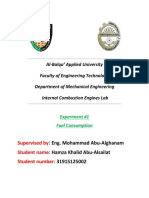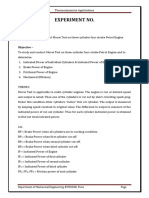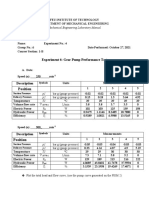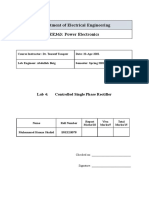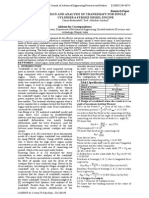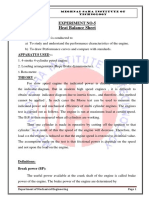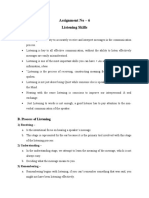1test On A Gear Pump
1test On A Gear Pump
Uploaded by
RAHUL DARANDALECopyright:
Available Formats
1test On A Gear Pump
1test On A Gear Pump
Uploaded by
RAHUL DARANDALEOriginal Title
Copyright
Available Formats
Share this document
Did you find this document useful?
Is this content inappropriate?
Copyright:
Available Formats
1test On A Gear Pump
1test On A Gear Pump
Uploaded by
RAHUL DARANDALECopyright:
Available Formats
Test on a Gear pump
EXPERIMENT NO. 1: TEST ON A GEAR PUMP
Title: Test on a Gear pump
Aim: To conduct test on a gear pump and plotting of its performance
characteristics such as,
1. Head Vs. Discharge
2. Head Vs. Input Power
3. Head Vs. Output Power
4. Head Vs. Overall Efficiency
Constructional Setup:
Figure No. 1.1 Gear Pump Test Setup
Dr. Vithalrao Vikhe Patil College of Engineering, Ahmednagar
1
Test on a Gear pump
Experimental Procedure:
1. Check all the connections properly
2. Ensure the proper oil level in the reservoir tank
3. Ensure that control valve is fully open
4. Start the setup
5. Wait for 1 minute to stabilize the setup
6. Close the control valve gently such that discharge pressure gauge shows 1 kg/cm2
7. Run the setup for 2 revolutions of the energy meter disc
8. Note down the time (sec.) required for that 2 revolutions of the energy meter disc
9. Simultaneously note down the initial and final reading from the measuring tank
10. Also note down the suction and discharge pressure readings
11. Drain out the oil from the measuring tank
12. Repeat the steps from 6 to 11 for next readings (for e.g. 2 kg/cm2,3 kg/cm2.....)
13. After taking few readings shut down the setup
Observations:
1. Energy meter constant (E) = 900 rev/(KW-hr)
2. Area of cross section of the measuring tank (A) = 900 cm2
3. Specific Gravity of the oil (s) = 0.84
4. No. of revolutions of the energy meter disc (n) = 2
5. Efficiency of Electric Motor (η) = 90 %
Observation Table:
Suction Delivery Discharge (Q)
Time
Sr. pressure pressure Initial Final Difference in
required
No. (Ps) (mm (Pd) Reading reading readings
(t) (sec.)
of Hg) (kg/cm2) (cm) (cm) (cm)
1. 80 1 7.4 11 3.6 35
2. 80 2 6.1 9.5 3.4 32
3. 80 3 8.7 11.4 2.7 31
4. 80 4 4.4 7.7 3.3 30
5. 80 5 4.2 7.5 3.3 28
6. 80 6 4.4 7.3 2.9 26
Dr. Vithalrao Vikhe Patil College of Engineering, Ahmednagar
2
Test on a Gear pump
Calculations:
1. Head (H):
Suction head (Hs) = Ps/(ρg)
e.g. Hs=(80*13.6*9.81)/(840*9.81) = 1.2952 m
Delivery head (Hd) = Pd/(ρg)
e.g. Hd=(1*104*9.81)/(840*9.81) = 11.9048 m
Total head (H) = Suction head (Hs)+ Delivery head (Hd)
=.................. (m)
e.g. H = 1.2952+11.9048 = 13.2 m
2. Discharge (Q):
Discharge (Q) = (C/S Area of measuring tank* Difference in readings)/Time
required
=.................. (m3/s)
e.g. Q = [900*10-4*(11-7.4)]*10-2/35 = 9.2571*10-5 (m3/s)
3. Input power:
Input power =
1
E∗t ( )
∗n∗η∗3600
=................ (kW)
e.g. Input power =
1
900∗35 (
∗2∗0 . 9∗3600 )
= 0.205 (kW)
4. Output Power:
Output Power = Pressure * Discharge
=................. (kW)
=(1*104*9.81)* 9.2571*10-5=9.0812 W = 9.0812*10-3 kW
5. Overall Efficiency (ηo):
Overall Efficiency = Output Power / Input power
=...................%
e.g. Overall Efficiency = 9.0812*10-3 / 0.205 = 0.04429 = 4.43 %
Graph:
Dr. Vithalrao Vikhe Patil College of Engineering, Ahmednagar
3
Test on a Gear pump
Figure No. 1.2 Performance Characteristics of Gear Pump
Result:
Sr. Head Discharge Input Power Output Power Overall
No. (m) (m3/s) (KW) (KW) Efficiency (%)
1.
2.
3.
4.
5.
6.
Conclusion:
Thus test on gear pump has been carried out and performance characteristics curves
are plotted for the same. From these curves following conclusions can be made,
1. The discharge nearly remains constant over wide range of head
2. Input power increases linearly with head
3. Input power curve has intercept on y-axis due to friction power
4. Output power first increases linearly with head but later on decreases
5. Output power curve passes through origin due to zero pressure
6. Efficiency curve shows average of Input power and Output power
***** End of Experiment *****
Dr. Vithalrao Vikhe Patil College of Engineering, Ahmednagar
4
Test on a Gear pump
Dr. Vithalrao Vikhe Patil College of Engineering, Ahmednagar
5
You might also like
- Discrete Mathematical Structures With Applications To Computer Science by J.P. Tremblay, R. Manohar PDFDocument510 pagesDiscrete Mathematical Structures With Applications To Computer Science by J.P. Tremblay, R. Manohar PDFPawan Kumar Pulivarthi61% (112)
- Machine Design Elements and AssembliesFrom EverandMachine Design Elements and AssembliesRating: 3.5 out of 5 stars3.5/5 (2)
- Thermodynamics Lab1Document20 pagesThermodynamics Lab1Alina AbdikadyrNo ratings yet
- ME 142L Gear Pump Test ExperimentmadeDocument8 pagesME 142L Gear Pump Test Experimentmadejoyce ramirezNo ratings yet
- تقارير مختبر محركات احتراق داخليDocument19 pagesتقارير مختبر محركات احتراق داخليwesamNo ratings yet
- Hot Cheetos LabDocument2 pagesHot Cheetos LabKristaVienaSindacNo ratings yet
- Pelton TurbineDocument13 pagesPelton TurbineHitarth ShahNo ratings yet
- Compressible Lab ReportDocument9 pagesCompressible Lab ReportCursed PirateNo ratings yet
- ABE131 PumpsPumpingUnitsDocument40 pagesABE131 PumpsPumpingUnitsMark Joshua BacanNo ratings yet
- (2018) Final Exam +solutions PDFDocument23 pages(2018) Final Exam +solutions PDFTman LetswaloNo ratings yet
- Exp:04 Name: Ashutosh Maurya Reg - No. 15BCL0166 Observations and Tabulation Table 1 Results of Gear PumpDocument11 pagesExp:04 Name: Ashutosh Maurya Reg - No. 15BCL0166 Observations and Tabulation Table 1 Results of Gear PumpDivanshu GoelNo ratings yet
- Me144l-2 Exp04Document16 pagesMe144l-2 Exp04Alfred Crhistian EbcasNo ratings yet
- Ojeda, Khen Mehko C. - Me 417-Bsme 4aDocument8 pagesOjeda, Khen Mehko C. - Me 417-Bsme 4akhinojidaNo ratings yet
- Observation and Calculation of Wind Turbine (100 Watts) (Expt. 03)Document10 pagesObservation and Calculation of Wind Turbine (100 Watts) (Expt. 03)thiha soe tunNo ratings yet
- May-June 2015 Proplusion-1Document3 pagesMay-June 2015 Proplusion-1srinithims78No ratings yet
- Hydraulics and Pneumatics Lab ManualDocument21 pagesHydraulics and Pneumatics Lab ManualNAVEEN KUMAR S NNo ratings yet
- IJANSER 2024 - Vol 8 (4) PP 73-78Document6 pagesIJANSER 2024 - Vol 8 (4) PP 73-78ismet sezerNo ratings yet
- Anurag Porte - IC Engines Lab Report: Lab-1: Performance Measurement of The EngineDocument11 pagesAnurag Porte - IC Engines Lab Report: Lab-1: Performance Measurement of The EngineAnurag porteNo ratings yet
- Expt. 2A - 4-Stroke Diesel Engine-Without DataDocument6 pagesExpt. 2A - 4-Stroke Diesel Engine-Without DataZen RuNo ratings yet
- Fluid Machine ExamDocument2 pagesFluid Machine ExamHagosMebrahtuNo ratings yet
- 6 Centrifugal BlowerDocument7 pages6 Centrifugal BlowerdhundterahoNo ratings yet
- The Pelton Wheel: 1 ObjectivesDocument8 pagesThe Pelton Wheel: 1 ObjectivesAbelBayartNo ratings yet
- Question Paper Code: 77006Document3 pagesQuestion Paper Code: 77006Vishnu Kumar G CNo ratings yet
- 3-QUESTION PAPER TEE 2020 Model PaperDocument2 pages3-QUESTION PAPER TEE 2020 Model PapermvzhvschdbsKNo ratings yet
- JETRO DELIMA - PERFORMANCE OF DIESEL POWER PLANT-Plate 1 (1st Sem 2024-25)Document9 pagesJETRO DELIMA - PERFORMANCE OF DIESEL POWER PLANT-Plate 1 (1st Sem 2024-25)QUEENE FAYETH TAGANASNo ratings yet
- Pelton ReportDocument9 pagesPelton Reportarchana.078bme004No ratings yet
- Wa0002.Document24 pagesWa0002.Shrey MistryNo ratings yet
- r05222202 Prime Movers and Mechanical ComponentsDocument9 pagesr05222202 Prime Movers and Mechanical ComponentsSRINIVASA RAO GANTANo ratings yet
- Heat Balance Diesel Rope Brake-6Document3 pagesHeat Balance Diesel Rope Brake-6Arup NaskarNo ratings yet
- 6 Morse TestDocument6 pages6 Morse TestdhundterahoNo ratings yet
- Pocket Formula GuideDocument68 pagesPocket Formula GuideMike StevensonNo ratings yet
- Position: Experiment 4: Gear Pump Performance TestDocument10 pagesPosition: Experiment 4: Gear Pump Performance TestPrecious Gallardo DerainNo ratings yet
- ThermalDocument40 pagesThermalvijayakumarNo ratings yet
- Department of Electrical Engineering EE363: Power ElectronicsDocument8 pagesDepartment of Electrical Engineering EE363: Power ElectronicsAbrahan ShahzadNo ratings yet
- 7 MCE 211-The Carnot CycleDocument8 pages7 MCE 211-The Carnot CycleAhmed Al-ayatNo ratings yet
- Heat Transfer Lab - NGS (1) (2) - YathinDocument48 pagesHeat Transfer Lab - NGS (1) (2) - Yathinswaroopdash.201me256No ratings yet
- Estrella, Tria A. BSME 5-1 ME 511a Machine Design 1 Exercise #1: Nature of Mechanical DesignDocument12 pagesEstrella, Tria A. BSME 5-1 ME 511a Machine Design 1 Exercise #1: Nature of Mechanical DesignHannahNo ratings yet
- The Effects of Two Shaft Gas Turbine Operating Conditions On The Overall PerformanceDocument16 pagesThe Effects of Two Shaft Gas Turbine Operating Conditions On The Overall PerformanceAhmad Mohammad Abdul-Aziz100% (1)
- Internal Combustion Engines: Laboratory ManualDocument22 pagesInternal Combustion Engines: Laboratory Manualnikhilpawar200316No ratings yet
- Centrifugal Pump Power MeasurementsDocument8 pagesCentrifugal Pump Power MeasurementsMahmoudSehweilNo ratings yet
- Experiment No.1 Test On Vane Pump and Plotting of Performance CharacteristicsDocument6 pagesExperiment No.1 Test On Vane Pump and Plotting of Performance CharacteristicsShivanand TalwarNo ratings yet
- Design and Analysis of Crankshaft For Single Cylinder 4-Stroke Deisel EngineDocument3 pagesDesign and Analysis of Crankshaft For Single Cylinder 4-Stroke Deisel EngineChetan GuptaNo ratings yet
- gears ExprimentDocument11 pagesgears ExprimentMahamed RamadanNo ratings yet
- Internal Combustion EnginesDocument14 pagesInternal Combustion EnginesElisha NissiNo ratings yet
- SOM Lab EXP6Document7 pagesSOM Lab EXP6Amisha SharonNo ratings yet
- Urquico ME152L-2 E01 Exp1Document14 pagesUrquico ME152L-2 E01 Exp1ubenydictNo ratings yet
- Fatigue of ShaftDocument8 pagesFatigue of ShaftSathish KumarNo ratings yet
- Exp-5 Heat Balance SheetDocument5 pagesExp-5 Heat Balance SheetRabeek RajaNo ratings yet
- Exp-5 Heat Balance Sheet PDFDocument5 pagesExp-5 Heat Balance Sheet PDFNarender NarruNo ratings yet
- Assignment 5Document2 pagesAssignment 5harsh gargNo ratings yet
- SUPPLEMENTARY TURBINES Rev2023Document2 pagesSUPPLEMENTARY TURBINES Rev2023jochiee2324No ratings yet
- Ii Mech ThermalDocument8 pagesIi Mech ThermalRameez FaroukNo ratings yet
- Detailed Energy Audit of Thermal Power Plant EquipmentDocument22 pagesDetailed Energy Audit of Thermal Power Plant EquipmentPajooheshNo ratings yet
- thrm317_mod10_6052Document34 pagesthrm317_mod10_6052sparesparespare69No ratings yet
- Reporte ANEXCELBASEDEDUCATIONALPLATFORMFORDESIGNANALYSESOFFLUIDTHERMALSYSTEMS Guzman Luis S.SDocument11 pagesReporte ANEXCELBASEDEDUCATIONALPLATFORMFORDESIGNANALYSESOFFLUIDTHERMALSYSTEMS Guzman Luis S.SLuigy GuzmanNo ratings yet
- 1Document11 pages1tyagipraveen03No ratings yet
- Experimental Determination of Low Speed Diesel Engine Crankshaft TwistingDocument7 pagesExperimental Determination of Low Speed Diesel Engine Crankshaft TwistingBui Duy ThanhNo ratings yet
- Experiment No. 2: Morse Test On Multi Cylinder Petrol EngineDocument7 pagesExperiment No. 2: Morse Test On Multi Cylinder Petrol EngineParas kapoorNo ratings yet
- Stringing Machine DesigningDocument12 pagesStringing Machine Designingarsalanhamid100% (1)
- Kaplan Turbine.Document13 pagesKaplan Turbine.Shravani GogawaleNo ratings yet
- Case Studies in Mechanical Engineering: Decision Making, Thermodynamics, Fluid Mechanics and Heat TransferFrom EverandCase Studies in Mechanical Engineering: Decision Making, Thermodynamics, Fluid Mechanics and Heat TransferRating: 5 out of 5 stars5/5 (2)
- Assignment No 1 - Personal SWOT AnaysisDocument2 pagesAssignment No 1 - Personal SWOT AnaysisRAHUL DARANDALE100% (1)
- To Extract Features From Given Data Set and Establish Training DataDocument2 pagesTo Extract Features From Given Data Set and Establish Training DataRAHUL DARANDALENo ratings yet
- Assignment 6 - Listening SkillsDocument3 pagesAssignment 6 - Listening SkillsRAHUL DARANDALE100% (1)
- Assignment No 2 Goal - SettingDocument18 pagesAssignment No 2 Goal - SettingRAHUL DARANDALENo ratings yet
- 1.to Study Supervisedunsupervisedreinforcement Learning ApproachDocument6 pages1.to Study Supervisedunsupervisedreinforcement Learning ApproachRAHUL DARANDALENo ratings yet
- 4.AIML - To Extract Features From Given Data Set and Establish Training DataDocument2 pages4.AIML - To Extract Features From Given Data Set and Establish Training DataRAHUL DARANDALENo ratings yet
- Assignment 4 - Letter Application WritingDocument3 pagesAssignment 4 - Letter Application WritingRAHUL DARANDALENo ratings yet
- Assignment 4 PLCDocument1 pageAssignment 4 PLCRAHUL DARANDALENo ratings yet
- SCADA ArchitechturesDocument9 pagesSCADA ArchitechturesRAHUL DARANDALENo ratings yet
- Assignment 5 PLCDocument1 pageAssignment 5 PLCRAHUL DARANDALENo ratings yet
- Assignment 1 PLCDocument1 pageAssignment 1 PLCRAHUL DARANDALENo ratings yet
- Assignment 2 PLCDocument1 pageAssignment 2 PLCRAHUL DARANDALENo ratings yet
- RGE Commands and KeybindsDocument2 pagesRGE Commands and KeybindsSpeedyNo ratings yet
- Pre Civil War DBQDocument3 pagesPre Civil War DBQrepathon100% (1)
- Shadowrun ArtistHandbook v01.00.00Document183 pagesShadowrun ArtistHandbook v01.00.00Natasha CraftNo ratings yet
- Pressure Transmitters Single-Range Transmitters For General ApplicationsDocument5 pagesPressure Transmitters Single-Range Transmitters For General ApplicationsGiancarlo MoiNo ratings yet
- KDI 1903M - KDI 2504M: Owner ManualDocument44 pagesKDI 1903M - KDI 2504M: Owner ManualJosko Prnjak100% (1)
- The Hope Probe's SuccessDocument3 pagesThe Hope Probe's SuccessSkygazers' Society100% (1)
- Rivals For Catan - Game RulesDocument28 pagesRivals For Catan - Game RulesProysenNo ratings yet
- Mobile Marketing Sample Assignment ResponseDocument8 pagesMobile Marketing Sample Assignment ResponseAkansha SinghNo ratings yet
- Drawing of Sectioned Views: Preparatory Year Engineering DrawingDocument7 pagesDrawing of Sectioned Views: Preparatory Year Engineering DrawingKareem AqeelNo ratings yet
- CSC 312 System Modelling Using UML Practice Exercises: Case Study: A Video Rental SystemDocument4 pagesCSC 312 System Modelling Using UML Practice Exercises: Case Study: A Video Rental SystemKc MamaNo ratings yet
- Bsi Haccp GMP GuideDocument6 pagesBsi Haccp GMP Guidebilal saeedNo ratings yet
- Sheet Music - Operetta - Romberg - East Wind - East Wind - in D Minor - OperettaDocument8 pagesSheet Music - Operetta - Romberg - East Wind - East Wind - in D Minor - Operettagary fransenNo ratings yet
- Bayesian Sparse Topical CodingDocument14 pagesBayesian Sparse Topical CodingchanceNo ratings yet
- Power System Operation and Control Jan 2024Document8 pagesPower System Operation and Control Jan 2024Shanmukh VegiNo ratings yet
- Jump, Loop, and Call: Yongjun Park Hanyang UniversityDocument29 pagesJump, Loop, and Call: Yongjun Park Hanyang UniversityBruno Carvacho YerkovichNo ratings yet
- Custom MCQ - 3 by VGDocument10 pagesCustom MCQ - 3 by VGIS WING APNo ratings yet
- Mercado Stm21 Problem SetDocument2 pagesMercado Stm21 Problem SetSamantha MercadoNo ratings yet
- (PPT) Thailand's Automotive Industry and Current EV Status - 5c864c90761f6Document34 pages(PPT) Thailand's Automotive Industry and Current EV Status - 5c864c90761f6Nut AssanaiNo ratings yet
- HW2 SDocument5 pagesHW2 S엄기웅No ratings yet
- Lecture 3-Building Rational AgentsDocument26 pagesLecture 3-Building Rational AgentsAbdullah KhanNo ratings yet
- BDW42 - NPN, BDW46, BDW47 - PNP: Darlington Complementary Silicon Power TransistorsDocument2 pagesBDW42 - NPN, BDW46, BDW47 - PNP: Darlington Complementary Silicon Power Transistorsاحمد زغارىNo ratings yet
- DNV Offshore Substation SafetyDocument12 pagesDNV Offshore Substation Safetytkdrt2166No ratings yet
- Audience Theory Handout 1Document8 pagesAudience Theory Handout 1api-370519901No ratings yet
- IgnitionDocument26 pagesIgnitionRyan ActonNo ratings yet
- A Long-Term Survival Guide - How To Make Ammo Can Wood StovesDocument6 pagesA Long-Term Survival Guide - How To Make Ammo Can Wood Stovesbuckonbeach100% (2)
- A319 320 321 Equipment PDFDocument48 pagesA319 320 321 Equipment PDFSuman BajracharyaNo ratings yet
- Topic 13 Exercise and ImmunityDocument43 pagesTopic 13 Exercise and Immunityaidanlee944No ratings yet
- Goals For Vancouver (February 1980)Document78 pagesGoals For Vancouver (February 1980)vcpcNo ratings yet




